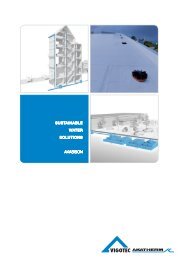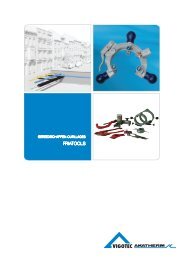Bekijk de PDF - VigotecAkatherm
Bekijk de PDF - VigotecAkatherm
Bekijk de PDF - VigotecAkatherm
You also want an ePaper? Increase the reach of your titles
YUMPU automatically turns print PDFs into web optimized ePapers that Google loves.
Bij kortstondige temperatuurverschillen, bijvoorbeeld bij het leeglopen van een<br />
bad, kan men met grote nauwkeurigheid <strong>de</strong> factor 0,5 op het temperatuurverschil<br />
toepassen. In dit geval wordt het aantal expansiemoffen in het voorbeeld<br />
gehalveerd: 0,5. 227 mm/56 = ~ 2,1 = 3 expansiemoffen.<br />
De algemene regel (totale lengte ≤ 5 m) kan toegepast wor<strong>de</strong>n op <strong>de</strong> meeste<br />
afvoertoepassingen. Bij uitzon<strong>de</strong>rlijke hoge temperatuursverschillen al dan niet<br />
in combinatie met een complexe leidingloop, dient het aantal expansiemoffen<br />
berekend te wor<strong>de</strong>n.<br />
8.3 Installatie in glijbeugels met lengtecompensatie d.m.v.<br />
buigbenen<br />
LB ≥ 10 x √Δl x d1,2<br />
Formule 8.2 bepaling buigbeenlengte<br />
LB = Lengte van buigbeen in mm<br />
d1 = Diameter buis<br />
Δl = Warmte lengterveran<strong>de</strong>ring<br />
L A = Beugelafstand<br />
L B = Buigbeenlengte<br />
L= Leidinglengte<br />
F= Fixatiepunt<br />
GL= Glijbeugel<br />
Δl= Lengteveran<strong>de</strong>ring<br />
Figuur 8.2 Installatie met buigbeen<br />
Voor <strong>de</strong> bepaling van <strong>de</strong><br />
buigbeenlengte in afvoerleidingen<br />
kan met <strong>de</strong> vereenvoudig<strong>de</strong> formule<br />
8.2 gerekend wor<strong>de</strong>n:<br />
Allereerst wor<strong>de</strong>n <strong>de</strong> lengteveran<strong>de</strong>ringen ΔL1 en ΔL2 bij het temperatuursverschil<br />
Δt bepaald (zie hoofdstuk 8.2).<br />
De minimale buigbeenlengte kan met formule 8.2 of uit <strong>de</strong> grafieken 8.2 en 8.3<br />
wor<strong>de</strong>n bepaald.<br />
Grafiek 8.2 Buigbeenlengte bij bedrijfstemperatuur 25°C - 100°C<br />
Pour <strong>de</strong>s variations <strong>de</strong> température ponctuelles (vidange baignoire par ex.), on<br />
peut, avec beaucoup <strong>de</strong> précision, appliquer le coefficient 0,5 sur la variation <strong>de</strong><br />
température. Dans ce cas, et pour l’exemple donné, le nombre <strong>de</strong> manchons <strong>de</strong><br />
dilatation est divisé par <strong>de</strong>ux : 0,5. 227 mm/56 = ~ 2,1 = 3 manchons.<br />
La règle générale (longueur totale ≤ 5 m) est d’application dans la plupart <strong>de</strong>s<br />
cas. Lors <strong>de</strong> variations <strong>de</strong> température extrêmes, que le tracé <strong>de</strong> la conduite soit<br />
complexe ou non, il faut calculer le nombre <strong>de</strong> manchons <strong>de</strong> dilatation.<br />
8.3 Installation à l’ai<strong>de</strong> <strong>de</strong> colliers coulissants et <strong>de</strong> bras <strong>de</strong><br />
flexion<br />
LB ≥ 10 x √Δl x d1,2<br />
Formule 8.2 calcul <strong>de</strong> la longueur du bras <strong>de</strong> flexion<br />
LB = Longueur du bras <strong>de</strong> flexion en mm<br />
d1 = Diamètre <strong>de</strong> la conduite<br />
Δl = variation <strong>de</strong> longueur due à la dilatation<br />
L A = Distance entre colliers<br />
L B = Longueur du bras <strong>de</strong> flexion<br />
L= longueur <strong>de</strong> la conduite<br />
F= point fixe<br />
GL= collier coulissant<br />
Δl= variation <strong>de</strong> longueur<br />
Figure 8.2<br />
Installation avec bras <strong>de</strong> flexion<br />
La calcul <strong>de</strong> la longueur du bras <strong>de</strong><br />
flexion se fait à l’ai<strong>de</strong> <strong>de</strong> la formule<br />
simplifiée 8.2:<br />
Il faut tout d’abord calculer les variations <strong>de</strong> longueur ΔL1 et ΔL2 dues à la<br />
variation <strong>de</strong> température Δt (cf chapitre 8.2).<br />
La longueur minimale du bras se calcule via la formule 8.2 ou se trouve dans les<br />
abaques repris en figures 8.2 et 8.3.<br />
Grafique 8.2 Longueur du bras <strong>de</strong> flexion pour une T° <strong>de</strong> service <strong>de</strong> 25°C - 100°C<br />
125<br />
BEUGELINGSMETHODE - FIXATION: METHODOLOGIE





